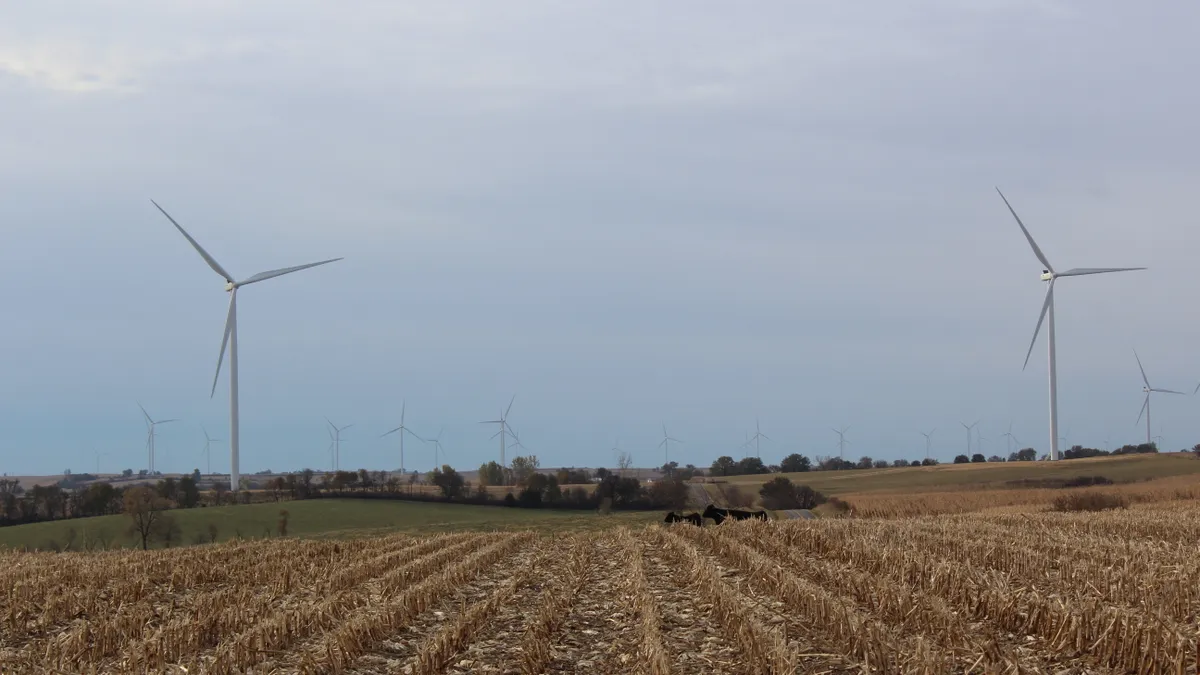Dive Brief:
- Ameren on Monday announced a committment to net-zero carbon dioxide emissions by 2050, in a move guided largely by investors and customers, according to the utility.
- Its latest plan strengthens the targets it set in 2017 — from 80% reduction by 2050 to 85% decrease by 2040, and allocates approximately $4.5 billion over the next decade to add 3.1 GW of new wind and solar to its system. The utility expects to have 5.4 GW of renewables in its portfolio by 2040.
- Ameren's plan would also keep coal-fired generation active into the 2040s, but pending negotiations over securitization legislation in Missouri could encourage the utility to retire those assets faster, according to stakeholders.
Dive Insight:
While an increasing number of states are setting ambitious clean energy targets, market forces are also driving utility actions to reduce emissions where there's no significant policy push, as Ameren has shown in its latest integrated resource plan. Though the utility operates in Illinois as well, its Missouri arm is the only one with generating assets, including over 5 GW of coal-fired facilities.
"In the context of Missouri, there is not a lot of support at the political level" for major decarbonization targets, said Ashok Gupta, senior energy economist for the Natural Resources Defense Council.
But though investors might be a big driver, much of the push also likely has to do with what utilities see as the long-term inevitability of some kind of government mandate, said Paul Patterson, an analyst with Glenrock Associates. "Although the state might not have [a renewable portfolio standard (RPS)] you might have something come down the line," whether it be at the federal or state level, over the next couple of decades.
"When you’re making these long-term integrated resource plans you’re forced to think long-term," Patterson said. "Investors are on board to a large degree with what they think may be more appropriate investments. ... I would say that ... there’s a question mark as to what the future’s going to be and there’s a movement for cleaner power."
Ameren said it primarily felt "interest from stakeholders like investors ... as well as our customers," to move toward cleaner resources, according to Marty Lyons, chairman and president of Ameren Missouri. "Customers we interact with, whether they be residential customers or business customers, are asking us to get as clean as we can as fast as we can."
Ameren's goals sit well above the state's RPS — Missouri has an RPS of 15% by 2021, a target the state has already exceeded. And its goals exceed those of 2017 significantly, according to stakeholders.
"Directionally, this is real good progress compared to 2017 plans," said Gupta. "With additional policies, we could go further, faster."

Like many investor-owned utilities, Ameren's planned investments are central to its long-term financial health, but it will be tricky getting regulators to sign off on investing in clean energy while still keeping existing coal-fired generation assets running into the 2030s and 2040s, according to Gupta. Securitization uses low-cost bonds to pay off the remaining depreciation life on coal plants at a lower capital cost, and is one way to wean utilities off coal-fired resources quicker.
“It's a way to basically increase your investment in clean resources, not on top of existing resources, but in place of existing resources,” said Gupta.
Though progress has been slow on getting a securitization bill for coal plants through the legislature because of how complicated the policy is, education and negotiations have been going well at the state level overall, he said.
As of now, the utility plans to keep its coal-fired assets online until the end of their life.
| Coal facility | Capacity | Intended retirement year |
|---|---|---|
| Meramec Energy Center | 812 MW | 2022 |
| Sioux Energy Center | 972 MW | 2028 |
| Labadie Energy Center (2 units) | 1,186 MW | 2036 |
| Rush Island Energy Center | 1,178 MW | 2039 |
| Labadie Energy Center (2 units) | 1,186 | 2042 |
Although the utility argues its coal-fired assets provide the utility with the financial and technical means it needs to transition to cleaner energy, it is "not opposed" to securitization, said Lyons. Because the utility's plan doesn't assume securitization, it won't be necessary to reach the decarbonization goals in its latest targets, but "to the extent securitization is proposed again moving forward, it's something that we'll take a look at carefully," he said.















